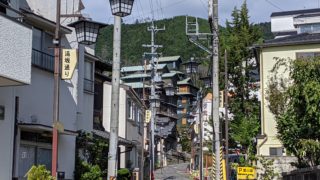Matsumoto’s Hidden Treasure: The Ikegami Tea House
In the shadow of Matsumoto Castle, our town’s most famous treasure, sits a jewel that few people know about: the Ikegami Tea House. Known more fondly by the name Hyakuchiku-tei, this is one slice of Matsumoto’s history worth endeavoring to see. Explore Matsumoto’s Hidden Treasure with us!

The Residence
Hyakuchiku-tei means “Hundred Bamboo Place” – a fitting name for the home that Matsumoto merchant Kisaku Ikegami built for himself in 1958. No longer a private residence, Hyakuchiku-tei is open to the public. What’s more, it costs nothing to go in and take a look around. But there is a catch: Hyakuchiku-tei is such a secret that they may seem a bit unprepared when you walk in. But a smile, a modest bow, and a polite “Ii desu ka?” (“Is it okay?”) should be enough to be graced with an invitation to take a self-guided gander.



The house itself is a prime example of that old-style Japanese vibe. And much of what you see is the real original thing, including the massive panes of glass that give a wide open view of the garden.



The Garden
The garden, never to be accused of being expansive, can nevertheless make you feel a world away from the bustling atmosphere over there on the other side of the castle. Stone paths lead you past swaths of low-lying broadleaf ‘sasa’ bamboo, among which sit a number of Ikegami’s subtle treasures. Beyond the gate of the modest wooden fence is a grove of taller bamboo. In the heat of the summer the bamboo leaves rustling softly in the breeze adds an extra sense of cool relief to this shelter from the sun. A variety of deciduous trees add shade, bear fruit, and turn color with the changing of the seasons.




The Tea House
At a glance, the small structure in the back corner of the garden could be mistaken for a shed. A closer look tells you it is much more. Like the garden spread out before it, this tea house is imbued with subtle details that can escape the casual observer but, once discovered, create an entirely new level of understanding and appreciation to your time here.


The stone path to the tea house first leads to the “koshikake”, a place where guests sit and wait before entering the tea house. The wall of bamboo facing this waiting area gives guests a sense of intimacy as they sit partially hidden from view of those in the residence on the other side of the garden. The tea house itself is designed in the Kyoto tradition, bearing characteristics that quietly tell the story of the history of Japanese tea ceremony.


Take In the Tea House
The tea house doors might be closed, but that doesn’t mean you can’t look inside. Still, it’s a good idea to ask if it’s okay to take a peek. “Cha-ya no naka, mite (‘mee-teh’) mo ii desu ka?” will do the trick.


Tea Ceremony Experience
Matsumoto offers the visitor plenty of treasures to seek out. The well-hidden Tea House at Hyakuchiku-tei, close to the castle though it is, might be the only one you can have all to yourself. Better yet, meet up with a few of the locals and experience the tea house as it was meant to be enjoyed: by taking part in an authentic tea ceremony! Click the link below to find out how.
Author Profile

Latest entries
 Sightseeing2023-12-18Handmade Soba, Simple Hiking & Hot Springs, All in Asama Onsen
Sightseeing2023-12-18Handmade Soba, Simple Hiking & Hot Springs, All in Asama Onsen Seasonal Topics2023-12-04Winter Wonderland: 5 Ways to Put Your Feet in the Matsumoto Snow
Seasonal Topics2023-12-04Winter Wonderland: 5 Ways to Put Your Feet in the Matsumoto Snow Other2023-07-14Shinshu Matsumoto Airport: Gateway to the Center of Japan
Other2023-07-14Shinshu Matsumoto Airport: Gateway to the Center of Japan History2023-07-07Matsumoto’s Old Kaido Roads: On the Trails of History
History2023-07-07Matsumoto’s Old Kaido Roads: On the Trails of History




One thought on “Matsumoto’s Hidden Treasure: The Ikegami Tea House”